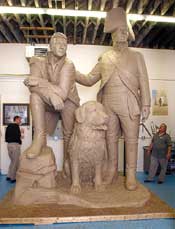|
|
 |
Lewis, Clark and Seaman are a big step closer to Sioux City
By
Michele Linck Journal staff writer

The twice-life-size work won high praise Thursday from representatives of the Missouri River Historic Development board that commissioned it. Steve Ponder and MRHD secretary Jean Sandman flew to see the sculpture at Kennedy's Loveland studio. Accompanying them were Alan Hansen, executive director of the new Lewis and Clark Interpretive Center, and Brent Koch, intern architect with the center's architect, Ruble Mamura Moss Brygger Architects of Sioux City.
The $315,000 sculpture will be the signature piece for the interpretive center, now under construction in Chris Larsen Park. The sculpture will be installed outdoors on a 2.5-foot-high stone base once the center is finished, probably early next summer. Both the sculpture and $3.2 million building are projects of the non-profit MRHD, charged with using the head tax from the Belle of Sioux City casino to improve the community.
"Oh, man! This is unbelievable!" Hansen exclaimed as he caught his first glimpse of the massive sculpture. "People are never going to believe the scale." Lewis' plumeless hat already nearly brushed the 14-foot-3-inch ceiling of Kennedy's studio. Kennedy reminded him that it would all seem much smaller outdoors.
Admiring Lewis' Great Newfoundland dog, Seaman, Ponder said, "I can just imagine his nose will be shiny from all the kids touching it. I think (the sculpture) turned out better and more detailed than even the models we've been seeing."
Kennedy designed the piece so children can climb on the base and pose for pictures with all three explorers.
"I think it's just excellent -- so realistic," Sandman said.
Hansen, too, was pleased with the likenesses. "When children think of Lewis and Clark, they're going to think of these faces," he said. "I love that."
While the MRHD representatives enjoyed their trip, it wasn't strictly for pleasure. Steve Boody, the Kansas City art consultant who is managing the sculpture project, said his firm requires the client to see and approve the work at the model stage and this stage, before it is produced in metal. MRHD will have to sign off on the second part of its contract and send a check next week.
The board has already taken possession of the 3-foot model, which is on display at the Sioux City Convention Center. Kennedy had made a couple of historical corrections to the big sculpture at MRHD's request: Lewis' hat needed to be turned slightly cock-eyed on his head and Clark's epaulet needed to be moved to his right shoulder to signify his captain's status. (While he shared captain duties with Lewis, President Thomas Jefferson promised, but failed, to give him the commission -- or its pension. President Clinton righted the slight before he left office nearly 200 years later.)
Once Kennedy finishes the plume and epaulet, the sculpture will be painted with rubber, covered in plaster and cut into about 100 pieces, a process taking about six weeks. The parts will be taken to the Loveland workshop of Art Castings of Colorado, which the Sioux City delegation also toured.
There they will be copied in wax, "sprued" with pipes to channel the liquid bronze, "shelled" in a ceramic coating into which the bronze is poured, welded back together, smoothed and coated with an antique brown patina. The process can take four months or more.
The finished sculpture will remain at Art Castings until the interpretive center is finished, then crated and shipped all in one piece to Sioux City where it will be installed in front of the center. Facing the sculpture in a landscaped setting will be a 150-foot flagpole bearing a 30-by-50-foot replica of the 15-star, 15-stripe American flag carried by Lewis and Clark.
The MRHD board plans to get the interpretive center up and running for a year or two, then turn it over to the city.
![]() Back |
Back |